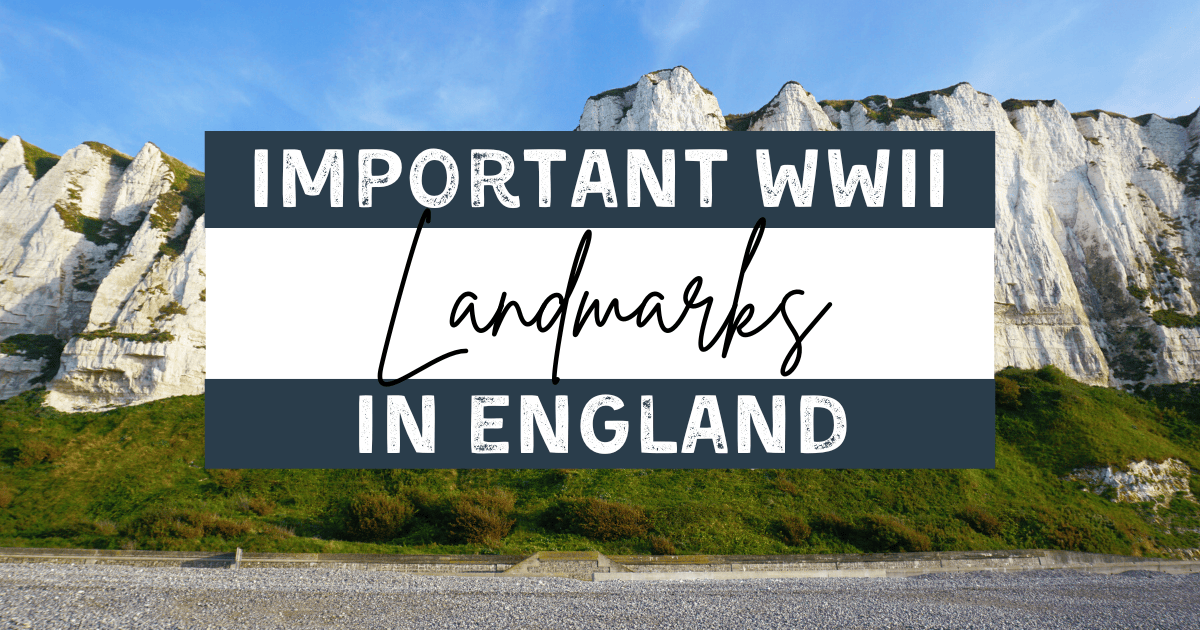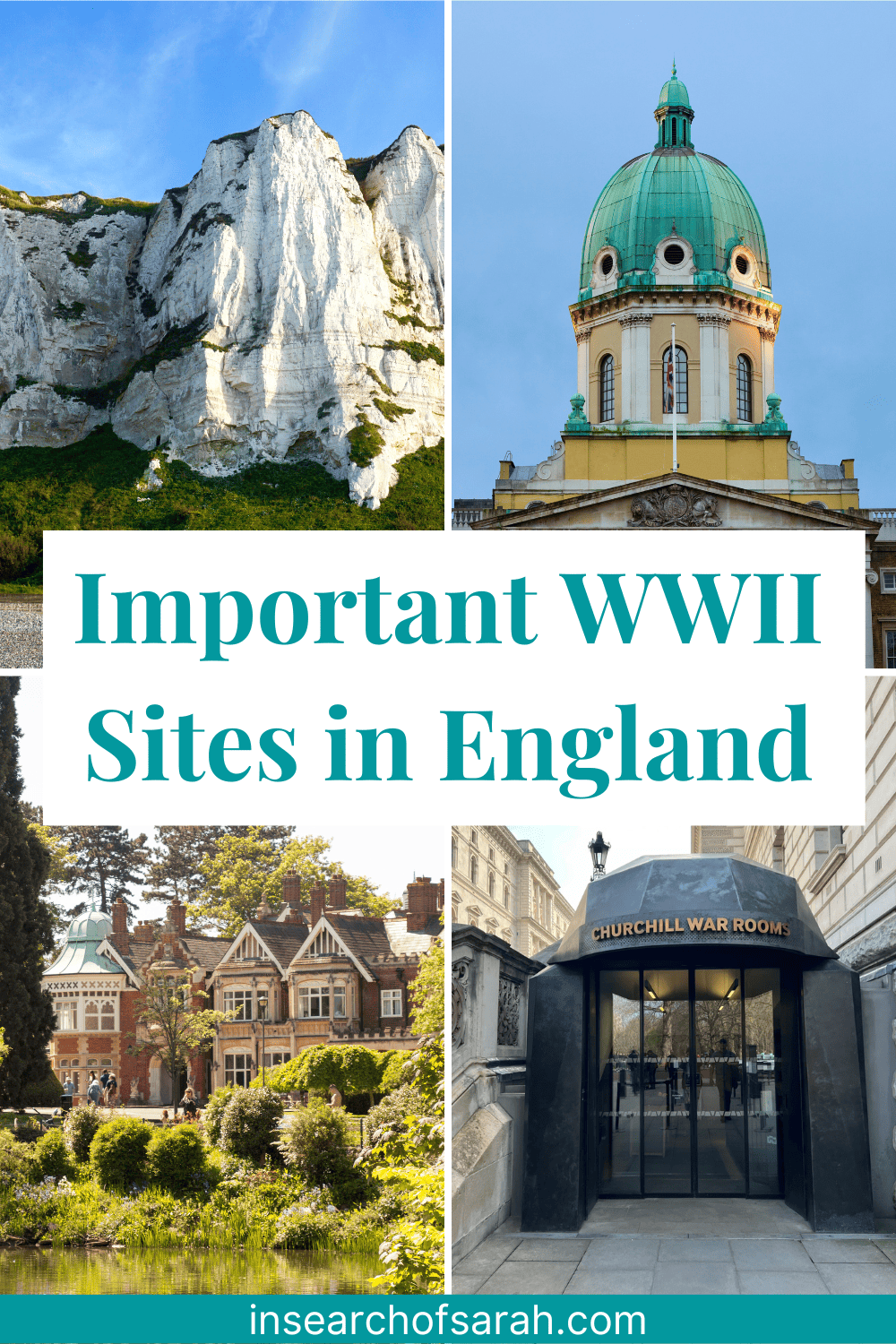World War II was a pivotal moment in global history, and England played a crucial role in the Allied efforts against the Axis powers.
Today, the remnants of that era can be explored through a journey to some of the most important World War II sites in the country.
From the Imperial War Museum to the Cliffs of Dover, the Churchill War Rooms to Bletchley Park, Southwick House, and the RAF Museum, these locations offer a poignant and educational look into the past.
Let’s explore 6 important WWII sites in England!

This post contains affiliate links which means I earn compensation when you click on the links at absolutely no extra cost to you! Feel free to read my disclosure policy. Thank you for supporting my blog!
Plan your next vacation using these tools!
✈️ Book flights: Expedia & SkyScanner
🏨 Book hotels: Booking.com & Expedia
🚘Book car rentals: RentalCars.com
🎫Book tours: GetYourGuide & Viator
🩹 DIY Travel Medical Kit
💸 20 Cheap Travel Items Under $20
Important World War II Sites in England
1. Imperial War Museum (London)
The Imperial War Museum in London stands as a comprehensive tribute to the military history of Britain and the Commonwealth.
Its WWII exhibits are particularly noteworthy, showcasing a vast array of artifacts, personal stories, and interactive displays.
You can explore the impact of the war on both the home front and the battlefield, and it’s hard not to gain a deep understanding of the sacrifices made during this tumultuous time.
One of the displays that really impacted me was the Holocaust exhibit. You’ll see personal belongings, testimonials, photos, and even a replica train car used for transport.

2. Cliffs of Dover
The iconic Cliffs of Dover served as a natural defense line during WWII. These towering chalk cliffs witnessed some of the most intense aerial battles of the war as the Royal Air Force (RAF) fought against the German Luftwaffe.
Today, you can stand atop these cliffs, taking in the breathtaking views while reflecting on the bravery of the pilots who defended Britain’s skies.
The walk along the Cliffs of Dover is one of my favourites. Be sure to tour the tunnels and the sound mirrors before stopping at Mrs. Knott’s Tea Room for a rest before making the hike back! It’s also recommended to bring a windbreaker/rain jacket with a hood in the event of poor weather.

3. Churchill War Rooms (London)
Step into the underground bunkers that sheltered Winston Churchill and his war cabinet during the Blitz.
The Churchill War Rooms in London offer a fascinating glimpse into the nerve center of British wartime operations.
Preserved exactly as they were during the conflict, these rooms provide an immersive experience, allowing you to sense the tension and urgency of the decisions made within their walls.
Be sure to allow at least two hours here. You’ll start in the Churchill Museum before making your way through the Cabinet War Rooms. It’s nearly impossible to picture yourselves in their shoes, working and living underground, all while bombing was happening right above you.

4. Bletchley Park
Known as the home of the Codebreakers, Bletchley Park was the top-secret centre where British intelligence, led by figures like Alan Turing, worked tirelessly to decrypt enemy codes, most notably the German Enigma.
Today, the site is a museum that pays homage to the incredible achievements of the codebreakers, showcasing the machines and methods that played a pivotal role in shortening the war.
You can pick up a free audio guide to self-tour around Bletchley Park, or take a free guided tour at certain times of the day. Save your ticket too, because your admission grants you access for a full year!

5. Southwick House
Located near Portsmouth, Southwick House served as the headquarters for General Dwight D. Eisenhower during the planning of the D-Day landings.
The map room, where the famous D-Day briefing took place, has been preserved and can be visited.
Walking through the rooms, visitors can almost feel the weight of the decisions made here. In fact, Eisenhower made the decision to delay D-Day by 24 hours (because of poor weather) in the library of Southwick House.
6. RAF Museum (Hendon)
The Royal Air Force Museum in Hendon, North London, houses an extensive collection of aircraft and exhibits related to the history of the RAF.
The museum consists of five buildings and hangars which showcase a series of exhibitions celebrating and commemorate the first 100 years of the RAF and its role today.
The museum’s WWII galleries feature iconic planes like the Spitfire and Lancaster Bomber, along with engaging displays that detail the role of the RAF in the conflict.
It’s a must-visit for aviation enthusiasts and anyone interested in the aerial aspect of WWII.

England’s Important WWII sites
Exploring these WWII sites in England provides a powerful and educational experience, allowing visitors to connect with the past and gain a deeper appreciation for the sacrifices and triumphs of that era.
From the strategic war rooms to the cliffs that witnessed historic battles, each site offers a unique perspective on a time that shaped the course of history.
Have you visited any of these WW2 sites in England?
Related Posts
- Exploring the Best Markets in London
- Is London Worth Visiting? (An Honest Review)
- Day Trip from Lewes Castle from London
- What to Expect at Warner Bros Studio: The Making of Harry Potter
- 16 Best Things to do in London on a Rainy Day
Pin it for later!


